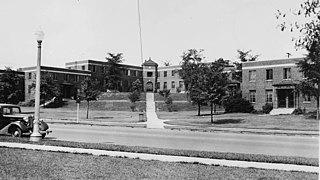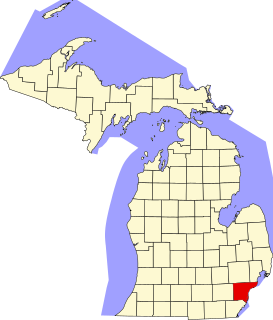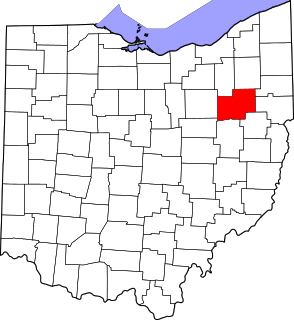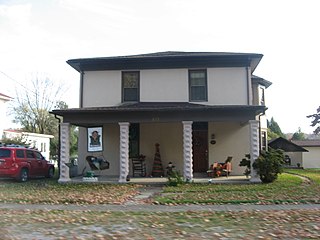
Cadiz is a village in Cadiz Township, Harrison County, Ohio, United States located about 20 miles from Steubenville. The population was 3,353 at the 2010 census. It is the county seat of Harrison County.

Freeport is a village in Harrison County, Ohio, United States. The population was 369 at the 2010 census.

Techwood Homes was an early public housing project in the United States, opened just before the First Houses. Located in Atlanta, Georgia, it replaced a shantytown known as Tanyard Bottom or Tech Flats. It was completed on August 15, 1936, but was dedicated on November 29 of the previous year by U.S. President Franklin D. Roosevelt. The apartments included bathtubs and electric ranges in each unit, 189 of which had garages. Central laundry facilities, a kindergarten and a library were also provided. Techwood was intended to eliminate the slums that the poor had been living in, but eventually became one itself.

This is a list of the National Register of Historic Places listings in Wayne County, Michigan.

The neighborhood of Irvington, named after Washington Irving, includes Irvington Historic District, a historic district in Indianapolis, Indiana. The historic district is a 545-acre (221 ha) area that was listed on the National Register of Historic Places in 1987. That year, the district included 2,373 contributing buildings, 5 other contributing structures, and 2 contributing sites.

The Indianapolis Public Library is the public library system serving the citizens of Marion County, Indiana, United States and its largest city, Indianapolis. The library was founded in 1873 and has grown to include a Central Library building, located adjacent to the Indiana World War Memorial Plaza, and 24 branch libraries spread throughout the county.

The George B. Cox House is a historic residence in Cincinnati, Ohio, United States. An Italianate building constructed in 1894, this two-and-a-half story building was built as the home of leading Hamilton County politician George B. Cox.

The Harrison–Landers House was a historic Federal-style residence near the village of Newtown in Hamilton County, Ohio, United States. Built in the first quarter of the nineteenth century, it served a range of residential and commercial purposes throughout its obscure history, but enough of its history was known to permit its designation as a historic site in the 1970s.

The Benninghofen House is a historic residence in Hamilton, Ohio, United States. Constructed in the 1860s, this house has been named a historic site for its high-quality architecture. Once the home of prominent Hamilton residents, it has been converted into a museum.

The Lane–Hooven House is a historic house museum in Hamilton, Ohio. Built in 1863 for Clark Lane, a Hamilton industrialist and philanthropist, the octagonal house features a brick exterior with Gothic Tudor elements. Other features include an open spiral staircase extending from the basement to the third floor turret, cast-iron fence, a greenhouse and a fountain. It was listed in the National Register on October 25, 1973.
The Puskarich Public Library System (PPL) is a rural, public library serving Harrison County, Ohio. The library also houses the Harrison County History of Coal Museum.

This is a list of the National Register of Historic Places listings in Stark County, Ohio.

The Paulding County Carnegie Library is a historic Carnegie library in the village of Paulding, Ohio, United States. Constructed in the early twentieth century, it is a simple building that has served as the core of Paulding County's library system since its construction, and it has been designated a historic site.

Warder Public Library is a historically significant building in Springfield, Ohio, United States. A robust example of Richardsonian Romanesque architecture, it was a gift to the city from industrialist Benjamin H. Warder, and served as the main branch of the Clark County Public Library from 1890 to 1989. It now houses the Clark County (Warder) Literacy Center.

The William H. Grant House is a historic house in Middleport, Ohio, United States. One of the area's earliest concrete houses, it has been designated a historic site.

The Middleport Public Library is a historic Carnegie library in the Ohio River village of Middleport, Ohio, United States. Built in the early twentieth century, it has been named a historic site.

The John H. Clark House is a historic residence in the village of Mechanicsburg, Ohio, United States. Built during Mechanicsburg's most prosperous period, it was the home of a prominent local doctor, and it has been named a historic site because of its historic architecture.

Lawler's Tavern is a historic commercial building in the village of Mechanicsburg, Ohio, United States. Built in 1830, it is one of the oldest buildings in the community, and it has been named a historic site.

The Brumback Library is a historic public library in the city of Van Wert, Ohio, United States. Opened at the beginning of the twentieth century in order to serve all residents of Van Wert County, it occupies an architecturally prominent building by David L. Stine, which was constructed with funds donated by a local businessman. The building has been named a historic site, partly because of its place as the first public library in the United States to serve an entire county.

The Freeport Main Street Historic District encompasses a 1-2 block area of Main Street in Freeport, Maine. It extends from Grove and Holbrook Streets in the south to Mill and Nathan Nye Streets in the north, just south of the L. L. Bean complex. The district, listed on the National Register of Historic Places in 1977, encompasses a well-preserved remnant of Freeport's 19th century town center.





















